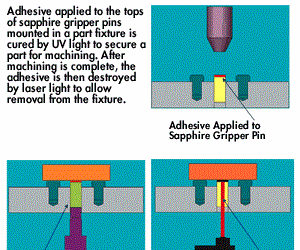Light-Activated Glue Holds And Releases Workpieces In A Flash
This alternative workholding method uses adhesive cured by UV light to "clamp" complex-shaped parts to a fixture. After machining, a quick laser beam "unclamps" the part by destroying the adhesive.
Share






ECi Software Solutions, Inc.
Featured Content
View More


Takumi USA
Featured Content
View MoreWorkpieces have been held with mechanical clamps, magnets and even ice. Now a Penn State engineer has developed a new technology that uses light-activated glue to hold workpieces in place for machining, grinding and other manufacturing processes. Light causes the glue to set, “clamping” the workpiece. Light, in the form of a laser, is also used to “unclamp” the workpiece by embrittling the once-set glue. Penn State holds a patent on the technology, but Master Work-Holding (Morganton, North Carolina) has optioned the intellectual property and plans to commercialize it.
Dr. Edward De Meter, the professor of industrial and manufacturing engineering who developed the concept, says, “This new technology offers an alternative to mechanical clamping, the approach industries most often use. Capital investment for automated clamping is typically high, and mechanical clamps can deform the workpiece, impede the manufacturing process and occupy processing space that could otherwise be used to hold additional workpieces. Adhering workpieces to a fixture avoids these problems and can lead to significant improvements in manufacturing productivity, part quality and part cost.”
In the new approach, the workpiece is bonded to a steel fixture that conforms to the underside of the workpiece. At strategic locations on its surface, the fixture has holes capped with small, round, raised pads made of commercial sapphire, a relatively inexpensive ceramic material. These pads, which Dr. De Meter calls gripper pins, act as lenses or windows for ultraviolet or infrared light used to set or destroy glue bonding the workpiece.
To load a workpiece, dabs of adhesive are placed on the gripper pins, and the workpiece is placed on top. A quick zap of low-intensity ultraviolet light from a UV spot lamp delivered through the gripper pins causes the adhesive to set. According to Dr. De Meter, setting the adhesive forms a strong, stiff bond between workpiece and fixture in seconds. The yield strength of the cured adhesive is said to be 6,000 pounds per square inch.
When machining or other processing is completed, infrared light delivered by a laser through the gripper pins destroys the adhesive bonds and releases the workpiece.
De-bonding occurs in a fraction of a second without heat transfer to the fixture or the workpiece. Dr. De Meter says that the adhesive used with the prototype system is a commercially available product used to assemble components in the electro-optics industry. Adding pigment to the adhesive makes it absorb infrared light, which embrittles the adhesive and causes the yield strength to drop below 300 psi.
“Usually the workpiece can be released from the fixture by hand or with a gentle tap with a rubber mallet,” Dr. De Meter explains.








































